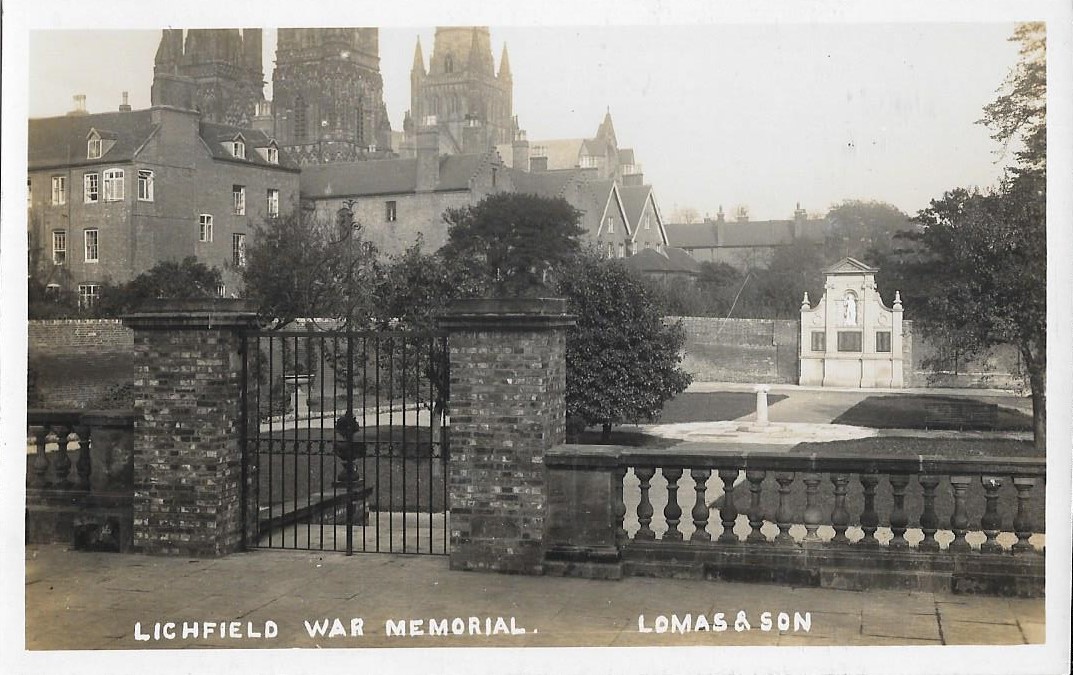For the first time in living memory there have been no formal remembrance ceremonies in the Garden of Remembrance this November. Nor was the City Council able to mark the centenary of the dedication of the Garden on 20th October.
While the war memorial itself features in many local books and photographs, the entrance to the Garden of Remembrance is often overlooked as people hurry through it to escape the noise of traffic in Bird Street before reaching the memorial and the relative tranquillity of its surroundings. However, the gateway has several features which repay close inspection.
The original listing in 1952 by what is now Historic England covers the war memorial, the memorial garden, the gate piers and arch, gate, the 18th century brick garden walls and 19th century stone balustrades.
The entrance gateway is described as comprising brick pillars surmounted by lions, a wrought iron arch above iron gates and balustrades to either side. The description adds that, while the ensemble is listed as an entity, "it is the memorial itself which possesses the more than special interest." The listing of all the component parts has recently been upgraded from Grade II to Grade II*.
Work on laying out the garden began in 1919 to a design by Charles Edward Bateman FRIBA (1863-1947) and was overseen by the City Surveyor, Mr P.A. Benn. Reinforced concrete foundations were needed to support the entrance gate pillars and balustrades, as much of the site had earlier been part of the marshy Moggs. The garden was opened, and the memorial unveiled, on 20th October 1920 by the Mayor, Councillor H.G. Hall, and dedicated by the Bishop of Lichfield.
A postcard published by Lomas and Son of Lichfield is of a photograph that was probably taken just before the dedication ceremony. The war memorial and garden layout are complete but the gates are closed. The tablet on the right-hand gate pier with the opening date has not been added and there is no sign of the tall heraldic stone lions that now sit on the ashlar caps of the gate piers and which bear the City's coat of arms.
The wrought iron entrance gates were made by J.C. Culwick of Lichfield. The arch (described by Historic England as "an ornamental overthrow") is also of wrought iron and bears the motto "PAX 1919" ("pax" of course being Latin for peace). The letters and numbers flow into one another, making them hard to decipher and easy to miss, especially when viewed against the background of mature trees.
It is often said that the stone lions on the gate piers reputedly came from Moxhull Hall at Wishaw, just over the boundary in Warwickshire, and the stone balustrades, urns and plinth came from Shenstone Court, just outside Lichfield. Regarding the balustrade, the 1927 official guide to Lichfield, published only a few years after the creation of the Garden, goes further: "The stone balustrade separating the Garden of Remembrance from the roadway has a curious interest not obvious at first sight. Originally at Moxhull Hall in Warwickshire, it was later removed to Shenstone Court, Lichfield, from which place it was acquired by the Corporation and once more transplanted to its present site."
Another feature of the entrance that is often overlooked is the ancient boundary stone built into the right-hand gate pier. As the 1927 Guide explains: "In one of the brick piers supporting the entrance gates is incorporated a stone removed from the old wall demolished at the time the garden was formed. This stone bears a rough weather-worn representation of the arms of the Cathedral [no longer discernible in 2020]. It marked the boundary between two parishes and is one of the halting-places of the Cathedral body on their perambulations of the Close on Ascension Day; it is also believed to have been one of the points at which, in the ancient custom of 'beating the bounds', fathers belaboured their sons." The historic boundary referred to is that of the corner of the Cathedral Close and the former parish of St. Mary's.
Along with the war memorial, the Garden of Remembrance, including its entrance, were restored about ten years ago. The reinforced concrete foundations of the gate and balustrade had subsided and the piers and lions were leaning backwards into the Garden. Jacking the pillars back up to the vertical proved not to be feasible, so they were taken down and re-erected. New steps, handrails and a much-improved ramp were also installed. The works were supported financially by the Heritage Lottery Fund and War Memorials Trust. The Garden of Remembrance is owned and managed by Lichfield City Council and the completed restoration won a British Association of Landscape Industries award in 2012.
Reference:
Lichfield: The Official Guide, was issued under the joint auspices of the Lichfield City Council and the Lichfield Chamber of Trade. (Ed. J. Burrow & Co. Ltd., 1927)
William Henwood
December 2020

The Memorial Garden in 1920
A Postcard from the author's collection